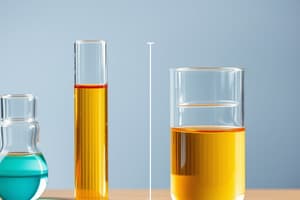Podcast
Questions and Answers
What is the degree of freedom for a one-component system existing in three phases?
What is the degree of freedom for a one-component system existing in three phases?
- 0 (correct)
- 1
- 2
- 3
Which of the following statements about components and phases is correct?
Which of the following statements about components and phases is correct?
- The same chemical species can exist in multiple phases simultaneously. (correct)
- A two-component system can only exist in two distinct phases.
- Components are the total number of phases present in a system.
- Phases are defined as the unique chemical reactions occurring in a system.
In a Temperature vs. Pressure diagram, what does a line represent?
In a Temperature vs. Pressure diagram, what does a line represent?
- Conditions where two phases coexist. (correct)
- Maximum degree of freedom.
- A point where three phases coexist.
- An area of fixed temperature.
How many degrees of freedom does an area represent in a Temperature vs. Pressure diagram?
How many degrees of freedom does an area represent in a Temperature vs. Pressure diagram?
Using the phase rule, which equation is correct for calculating the degree of freedom?
Using the phase rule, which equation is correct for calculating the degree of freedom?
Flashcards are hidden until you start studying
Study Notes
Phase Rule Overview
- The degree of freedom refers to the minimum number of independent variables required to completely define a system's state, such as temperature and pressure.
One Component System
- Components are the individual chemical species within a system; for example, water (H2O) is a single component.
- Phases are the distinct physical forms of the components; water exists in three phases: solid (ice), liquid (water), and gas (steam).
- The Phase Rule is expressed as F = C - P + 2, where:
- F represents the degree of freedom,
- C signifies the number of components,
- P denotes the number of phases.
Example: Water System
- Water has one component, represented as C = 1.
- It can exist in three distinct phases, noted as P = 3.
- When applying the phase rule to water:
- Calculate F = 1 - 3 + 2, resulting in F = 0.
- A zero degree of freedom indicates that both temperature and pressure are fixed to maintain equilibrium.
Graphical Representation
- The Temperature vs. Pressure Diagram illustrates the relationship between temperature and pressure in a system.
- Regions in the diagram indicate areas where two phases coexist.
- Curves in the graph reflect the conditions under which three phases coexist.
- The Triple Point is a specific point representing the coexistence of all three phases in equilibrium.
- Degree of Freedom in the diagram:
- Areas correspond to 2 degrees of freedom (two variables can change),
- Lines denote 1 degree of freedom,
- Points indicate 0 degrees of freedom.
- The maximum degree of freedom for a one-component system is 2, allowing for variation in both temperature and pressure.
Studying That Suits You
Use AI to generate personalized quizzes and flashcards to suit your learning preferences.




